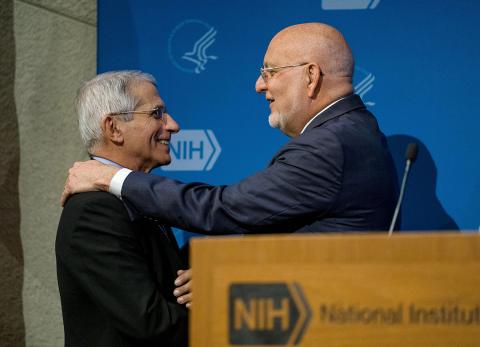CDC Fights Opioid Crisis, Infectious Disease Outbreaks

Photo: Andrew Propp
The opioid epidemic is the most serious public health crisis of our time, said Dr. Robert Redfield, director of the Centers for Disease Control and Prevention.
“I have seen the pain this epidemic has caused in many, many lives,” Redfield said at the recent NIAID Kinyoun Lecture in Lipsett Amphitheater.
Since 2000, more than 600,000 people have died from a drug overdose, he added. Most involved opioids. Others were from cocaine and methamphetamine. Many of these drugs are now contaminated with fentanyl, a synthetic opioid that’s 50 to 100 times more potent than morphine. Redfield predicted synthetic opioids will only get more potent.
There is a stigma associated with drug addiction and with relapse after treatment. Stigma—“the enemy of public health”—prevents people from coming forward and admitting they have a problem. Addiction is a medical condition, not a moral failure, he said.
Under Redfield’s leadership, the CDC has invested in opioid overdose surveillance programs. Previously, the CDC received data from state and local health departments. Usually, that data was a year or two old. Now, the agency gets overdose data directly from state medical records within 48 hours. One of the hardest hit areas in the country is West Virginia.
“We can see where the drug overdoses are in real-time and that’s really important in trying to respond to the outbreak,” he explained. “The medical records themselves become the surveillance tool.”
The agency has also funded prescription drug monitoring programs to identify opioid prescription misuse and developed guidelines for prescribing opioids for chronic pain.
“It is probably one of the most serious medical decisions we make when we prescribe opioids to a patient,” Redfield said. “We don’t have an understanding the way we should about the long-term potential consequences to that pain management system.”
He recalled when he was an AIDS researcher in the 1980s; scientists didn’t see a path to success. At first, they saw people dying in the prime of their lives. But researchers followed the science. They learned about the life cycle of the virus, developed an arsenal of drugs to suppress it and slowed its spread with tools of prevention.
“HIV is a highly treatable disease where you can live a natural lifetime,” Redfield said. “I am confident that science will do the same for addiction.”
While the CDC battles the opioid epidemic, it must also confront an increasing number of infectious disease outbreaks in the country. Intravenous drug use can “have significant impact when it comes to transmitting infectious diseases such as HIV and hepatitis C.”

Photo: Andrew Propp
Over a 3-year period in Scott County, Indiana, more than 233 people who injected drugs were diagnosed with HIV. Redfield said there are 220 other counties “where injection drug use could lead to substantial infectious disease outbreaks.”
Many of the counties at risk for disease outbreaks are the same counties where opioid use is highest, he explained. These parts of the country are working with health professionals and law enforcement agencies to develop a community-wide response before an outbreak happens.
What frustrates Redfield is “science on the shelf,” meaning that, while safe and effective drugs are available today, they aren’t getting to the people who need them. Doctors can, for example, treat patients with hepatitis C. But while treatments are available, hepatitis C infections are on the rise, particularly among populations who inject drugs.
Redfield encouraged the audience to never give up on the power of science. “As we confront the epidemics of HIV, hepatitis C and opioids, we have to see the possible, use the power of science and lead the nation to act,” he concluded.
